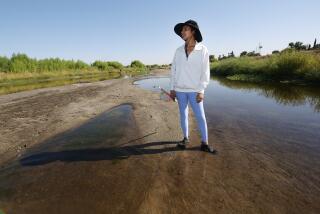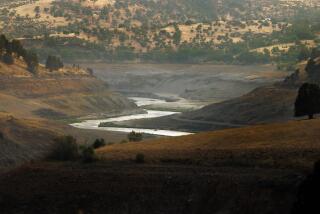Interior’s Legal Swamp
With elaborate drama, Secretary of Interior Donald P. Hodel moved one year ago to close Kesterson Reservoir in the San Joaquin Valley because selenium-polluted irrigation runoff was killing and deforming waterfowl in the Kesterson Wildlife Refuge. Stunning everyone, Hodel further directed that the Bureau of Reclamation close the tap on irrigation-water supplies to the 42,000 acres of farms drained by the San Luis Drain and Kesterson. Involved were 53 farms in the Firebaugh-Mendota region of western Fresno County.
The secretary later relented on the precipitous irrigation-water shutoff, but the Interior Department and Westlands Water District signed an agreement under which Kesterson would be closed by this June 30. A contractor hired by Westlands has started plugging the field drains that allow the runoff to flow into the San Luis Drain and Kesterson.
Then Westlands and Interior will pick a proposal for permanently ridding Kesterson of the selenium, a naturally occurring element that was leached from its deposits by the seepage of the irrigation drain water. Meanwhile, the 53 farms will continue to get irrigation water, but no longer can dispose of the runoff in Kesterson.
It may sound as if the Department of Interior has been a model of good government in handling the Kesterson situation. The chain of events was set off by the state Water Resources Control Board in February, 1984--about the time that Hodel became Interior secretary. The board gave the Bureau of Reclamation three years to clean up Kesterson.
But just how dedicated the Interior Department is to a timely and environmentally sensitive solution to the Kesterson problem? During the past year, Westlands and the Environmental Defense Fund--two old foes--agreed on a joint cleanup research effort to be financed by a $3.7-million federal loan. Congress passed a bill approving the loan, but the Interior Department has refused to advance the money--blocking it on the advice of Department Solicitor Ralph W. Tarr, who recently went to Washington from a Fresno law firm with major agribusiness clients. Efforts to get Tarr to explain his sketchy legal opinion have failed.
Subsequently, all the players agreed on substitute legislation to be carried by Sen. Pete Wilson (R-Calif.). But Tarr told Wilson’s office late last week that his proposal also had legal flaws. The bill was put on hold.
Meanwhile, farmers in the 42,000-acre region served by Kesterson are complaining, with some justification, that they have been left twisting in the wind by the Interior-Westlands process. Hodel has declined to respond to their Jan. 31 request to keep the drains opened for another year at reduced inflow. Now they have sued.
Without drainage, the water table will rise and kill their crops, the farmers claim. Given that prospect, their land in effect has been rendered worthless. It seems unlikely that Interior or Westlands can, or should, back out of their Kesterson closure plan now. But they have some obligation to minimize losses to the unfortunate growers.
Kesterson had the makings of an environmental nightmare a year ago. Hodel overreacted in an apparent attempt to cut political losses. The Westlands-Environmental Defense Fund agreement was hailed as a model of agribusiness-environmental cooperation in the search for a long-term solution to farm-drainage problems.
But now the Interior Department stubbornly and inexplicably blocks a $3.7-million loan supported not only by the California farming industry but by environmentalists as well. The Interior position not only should be explained, it also should be quickly reversed.
More to Read
Sign up for Essential California
The most important California stories and recommendations in your inbox every morning.
You may occasionally receive promotional content from the Los Angeles Times.










